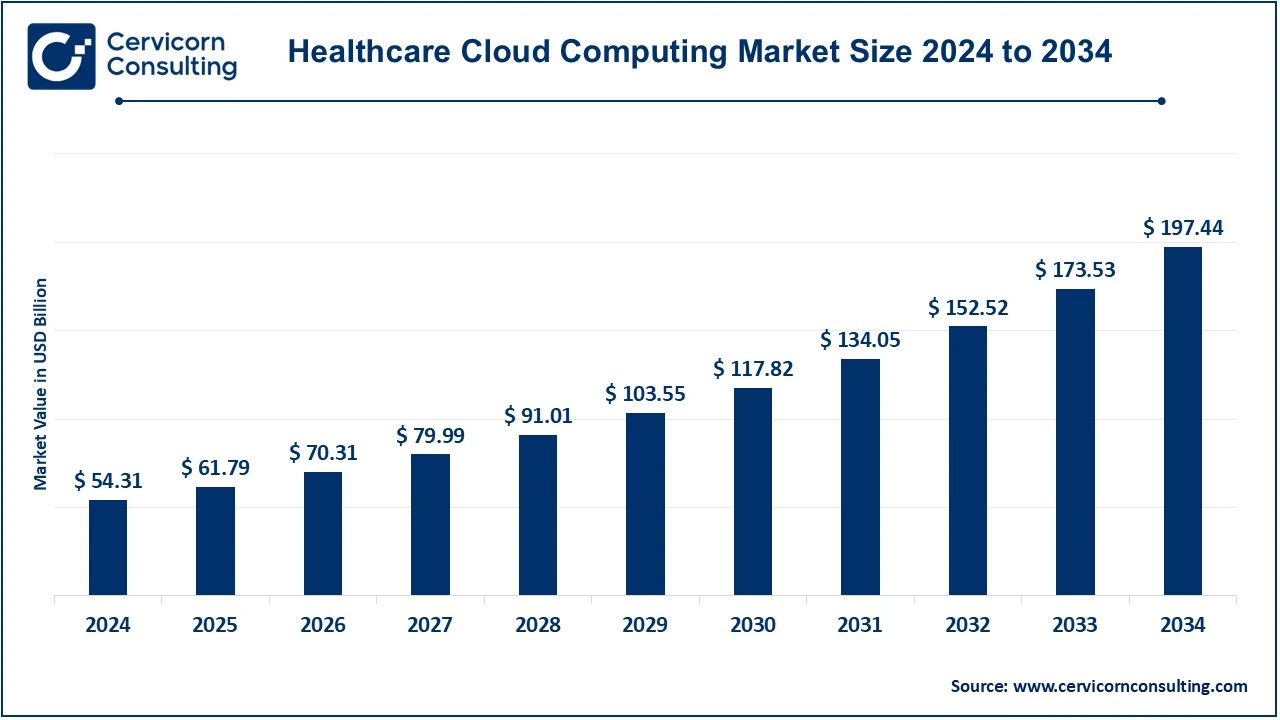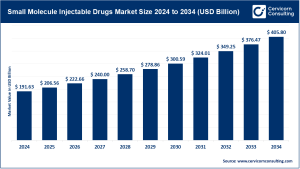Market Overview
The global healthcare cloud computing market is undergoing significant growth, fueled by the increasing shift toward digital health solutions and the rising need for scalable IT infrastructure in healthcare. In 2024, the market is valued at USD 54.31 billion and is forecasted to climb to nearly USD 197.44 billion by 2034, advancing at a strong CAGR of 13.77% from 2025 to 2034. Cloud technology is redefining how healthcare providers store and manage patient data, deliver virtual care, and integrate advanced innovations such as artificial intelligence (AI), big data analytics, and IoT-driven health monitoring systems.
Key Market Trends
1. Expanding Role of AI and Big Data
Healthcare institutions are increasingly embedding AI-powered analytics and big data capabilities into cloud platforms to enhance diagnosis accuracy, improve predictive modeling, and enable personalized care plans. For instance, cloud-enabled AI tools can scan vast amounts of electronic health records (EHRs) to identify risk factors and suggest preventive measures.
2. Surge in Telehealth and Virtual Care
The COVID-19 pandemic accelerated the adoption of telemedicine, with cloud technology at its core. Cloud-based telehealth platforms support secure video consultations, smooth data exchange, and remote access to medical records. This trend remains especially strong in North America and Asia-Pacific, where demand for digital healthcare services continues to surge.
3. Rising Preference for Hybrid and Multi-Cloud Solutions
Many healthcare organizations are transitioning from single-cloud systems to hybrid and multi-cloud frameworks. These models balance cost-effectiveness, compliance with data sovereignty laws, and enhanced data security, while also improving system redundancy and flexibility.
4. Stronger Emphasis on Data Security and Compliance
Data privacy remains a top concern in healthcare. To comply with frameworks such as HIPAA and GDPR, cloud providers are investing in advanced encryption technologies, blockchain-based security mechanisms, and real-time threat monitoring systems.
5. Growth of IoT-Enabled Healthcare Devices
The use of wearables, remote patient monitoring systems, and IoT-based medical devices is generating massive streams of patient data. Cloud infrastructure plays a crucial role in storing, analyzing, and providing real-time access to this data, paving the way for more data-driven healthcare services.
Market Drivers
-
Growing Demand for Digital Health
Adoption of EHRs, mobile health apps, and telemedicine is driving the reliance on cloud infrastructure. As of 2024, over 80% of hospitals in developed markets have integrated cloud-based EHRs, resulting in improved operational efficiency and enhanced patient care. -
Supportive Government Programs and Regulations
Global governments are encouraging digitization in healthcare. For example, the HITECH Act in the U.S. supports cloud adoption, while Europe’s EHDS (European Health Data Space) promotes interoperable systems for cross-border data sharing. -
Scalability and Cost Efficiency
Cloud computing can reduce IT infrastructure expenses by 30–40% compared to traditional systems. This is especially attractive for small and mid-sized healthcare facilities, enabling them to scale services based on patient needs. -
Advances in Cloud Technology
Innovations in AI, blockchain, and edge computing are boosting the performance and reliability of cloud platforms, allowing faster data access, real-time decision-making, and improved healthcare outcomes. -
Shift Toward Patient-Centric Models
As patients increasingly seek personalized and accessible healthcare, providers are embracing cloud platforms that consolidate data from multiple devices and apps into a single, unified ecosystem.
Impact of Trends and Drivers
-
By Segment: The fastest-growing areas include telehealth and remote patient monitoring, driven by the rising demand for virtual consultations and connected devices.
-
By Region: North America leads the market due to robust government support and mature IT systems, while Asia-Pacific is the fastest-growing region, supported by healthcare digitization initiatives.
-
By Application: Cloud-based EHR and analytics dominate applications, but AI-driven diagnostics and wearable integrations are rapidly gaining traction.
Challenges & Opportunities
-
Challenges: Ongoing concerns about data security, complex regulatory landscapes, and high upfront migration costs hinder adoption in some regions.
-
Opportunities: Expanding use of AI-powered cloud tools, blockchain security, and multi-cloud models creates vast opportunities for innovation and competitive differentiation.
Future Outlook
The healthcare cloud computing market is set for sustained growth, with a projected CAGR of 13.77% over the next decade. By 2034, the market is anticipated to exceed USD 197.44 billion, supported by the convergence of AI, IoT, cloud, and big data analytics. The future points toward highly integrated healthcare ecosystems, where cloud platforms act as the backbone for collaboration, innovation, and patient-first solutions.
📩 Contact Us for a detailed market overview and customized insights.

